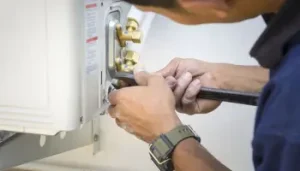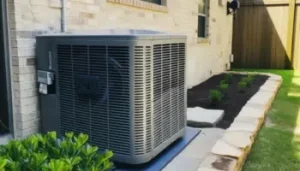In today’s age of smart technology, smart thermostats are revolutionizing how we manage our home’s heating and cooling systems. These devices offer advanced features that not only enhance comfort but also significantly improve energy efficiency, leading to cost savings. This comprehensive guide will explore the benefits of smart thermostats, how they work, and provide tips for integrating them into your HVAC system for maximum efficiency and comfort.
What is a Smart Thermostat?
A smart thermostat is a Wi-Fi-enabled device that allows you to control your home’s heating and cooling system remotely through a smartphone, tablet, or computer. Unlike traditional thermostats, smart thermostats offer advanced features such as learning your schedule, adjusting temperatures automatically, and providing energy usage reports.
Benefits of Smart Thermostats
- Energy Efficiency and Cost Savings
- Smart thermostats can significantly reduce energy consumption by learning your schedule and adjusting temperatures accordingly. This ensures that your HVAC system is not running unnecessarily when you are not home, leading to substantial cost savings on your energy bills. Regular inspection of HVAC systems also helps in energy savings.
- Remote Control and Accessibility
- With a smart thermostat, you can control your home’s temperature from anywhere using your smartphone. This feature is particularly useful for adjusting the temperature before you arrive home or while you are on vacation.
- Learning Capabilities
- Many smart thermostats come with learning algorithms that adapt to your schedule and preferences over time. These devices automatically adjust the temperature based on your habits, ensuring optimal comfort without the need for manual adjustments.
- Energy Usage Reports
- Smart thermostats provide detailed energy usage reports, allowing you to monitor and analyze your consumption patterns. This information can help you make informed decisions to further reduce energy usage and costs.
- Integration with Other Smart Devices
- Smart thermostats can integrate with other smart home devices such as Amazon Alexa, Google Assistant, and Apple HomeKit. This allows for seamless voice control and automation, enhancing the overall smart home experience.
How Smart Thermostats Work
Smart thermostats operate by connecting to your home’s Wi-Fi network and communicating with your HVAC system. Here’s a step-by-step overview of how they function:
- Installation
- Smart thermostats are relatively easy to install and typically come with detailed instructions. However, if you are not comfortable with DIY installations, it is recommended to hire a professional to ensure proper setup and compatibility with your HVAC system.
- Connection to Wi-Fi
- Once installed, the thermostat connects to your home’s Wi-Fi network, enabling remote access and control through a dedicated app on your smartphone or tablet.
- Learning and Adaptation
- After installation, the thermostat begins to learn your schedule and temperature preferences. Over time, it creates a personalized heating and cooling schedule that maximizes comfort and efficiency.
- Sensors and Geofencing
- Smart thermostats use sensors to detect occupancy and adjust temperatures accordingly. Geofencing is another feature that uses your smartphone’s location to determine when you are home or away, automatically adjusting the temperature to save energy.
- Energy Monitoring
- The thermostat continuously monitors your energy usage and provides reports through the app. These reports offer insights into your consumption patterns and suggest ways to optimize energy efficiency.
Tips for Integrating Smart Thermostats into Your HVAC System
- Ensure Compatibility
- Before purchasing a smart thermostat, ensure that it is compatible with your existing HVAC system. Most smart thermostats work with standard heating and cooling systems, but it is essential to verify compatibility to avoid any issues during installation.
- Professional Installation
- While smart thermostats are designed for easy installation, it is advisable to hire a professional for a seamless setup, especially if you are unfamiliar with your HVAC system’s wiring.
- Optimize Thermostat Placement
- Place the thermostat in a central location away from direct sunlight, drafts, and heat sources. This ensures accurate temperature readings and optimal performance.
- Utilize Scheduling Features
- Take advantage of the scheduling features to set different temperatures for various times of the day. For example, you can lower the temperature while you are asleep or away from home to save energy.
- Regular Maintenance
- Regularly check and update the thermostat’s software to benefit from the latest features and improvements. Additionally, ensure that your HVAC system is well-maintained to complement the efficiency provided by the smart thermostat.
- Leverage Geofencing and Sensors
- Enable geofencing and occupancy sensors to allow the thermostat to adjust temperatures based on your location and presence in the home. This feature can significantly enhance energy efficiency and comfort.
- Monitor Energy Reports
- Regularly review the energy usage reports provided by the thermostat. These insights can help you identify patterns and make necessary adjustments to further optimize energy consumption.
Conclusion
Smart thermostats are an excellent investment for homeowners looking to enhance comfort, improve energy efficiency, and save on utility bills. By understanding how these devices work and following the tips for integration, you can maximize the benefits of your smart thermostat. For professional installation and maintenance services, trust Diamond Heating and Cooling to ensure your HVAC system operates at peak efficiency. For more information on smart thermostats and other HVAC solutions, visit Diamond Heating and Cooling. Our team of experts is dedicated to helping you achieve optimal comfort and energy savings in your home.



